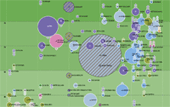GENDER EQUITY INDEX (GEI)
In most societies men and women are assigned different responsibilities, rights, benefits and opportunities in the activities they perform, in access to control of resources and in decision-making processes. Since 2007 Social Watch has been developing the Gender Equity Index (GEI) to make gender inequities more visible and to monitor the evolution in the different countries of the world. The GEI is based on information available that can be compared internationally, and it makes it possible to classify countries and rank them in accordance with a selection of gender inequity indicators in three dimensions, education, economic participation and empowerment.
The way the GEI is calculated is a response to the need to reflect all situations that are unfavourable to women. When there is a situation in which women are at a proportional disadvantage with respect to men, the GEI does not reach its maximum value of 100 points. The final value on the index depends on the degree of negative inequity for women prevailing in a given country or region regardless of whether there may also be inequities that are positive for women (that is to say negative for men).
|
The Gender Equity Index (GEI) measures the gap between women and men in education, the economy and political empowerment.
|

The Gender Equity Index 2009 computed by Social Watch shows that the gender gap is not narrowing in most countries and a majority of the countries that show progress are those that were already comparatively better.
|
SUSCRIBE TO OUR NEWSLETTER




